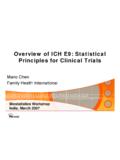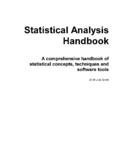Transcription of Clinical Trial Synopsis QB-0011 - Prevagen
1 QUINCYBIOSCIENCETITLE: Madison Memory Study: A Randomized, Double-Blinded, Placebo-Controlled Trial of Apoaequorin in Community-Dwelling, Older Adults SPONSOR: Quincy Bioscience, LLC PRINCIPAL INVESTIGATOR: Kenneth C. Lerner, Quincy Bioscience, LLC OBJECTIVE:The primary objective of the Madison Memory Study was to determine whetherPrevagen with apoaequorin (10 mg) improves quantitative measures of cognitive function in community dwelling, older adults STUDY DATES:3 December 2009 to 13 April 2011 REPORT DATE:1 August 2016 2016 Quincy Bioscience. All rights reserved. All trademarks are the property of Quincy Bioscience, LLC. 726 Heartland trail , Suite 300, Madison, Wisconsin, Trial Synopsis QB-0011 Quincy BioscienceQB-0011 INTRODUCTION Apoaequorin is a protein originally found in a species of jellyfish (1).
2 It is available commercially in a dietary supplement and has been determined to be safe (2) and non-allergenic (3). Apoaequorin has been shown in laboratory studies to support neuronal cells (4), (5). Based on in vitro and in vivo animal studies (4), (5), (6), (7), we hypothesized that apoaequorin has the potential to enhance memory and cognitive function in humans. Previous work with apoaequorin in aged canines demonstrated cognitive enhancement (7). STUDY DESIGN The Madison Memory Study was a randomized, double-blind, placebo-controlled study designed to examine the effect of apoaequorin on cognitive function in older adults. Community dwelling participants were randomized into either the Experimental group (apoaequorin) or Control group (placebo) at a ratio of 3:2. Participants in the Control group received capsules containing only white rice flour.
3 Participants in the Experimental group received capsules containing apoaequorin (10 mg) and white rice flour. Capsules were size and color matched. Participants were instructed to take one (1) capsule daily for the duration of the study. To segregate participants by their level of self-reported cognitive impairment, a Baseline participant score was acquired using the AD8 screening tool. The AD8 is a brief (8-question) screening tool that was developed to differentiate adults facing normal cognitive aging from those with early signs of dementia (8), (9), (10). In this study, an AD8 score of 2 was used as a cut-off value to discriminate between those people who are cognitively normal or very mildly impaired (AD8 0-2) versus those with higher levels of impairment (AD8 3-8). Because Prevagen is a dietary supplement intended for healthy, non-demented individuals, results from the AD8 0-1 and AD8 0-2 subgroups are the most relevant to the efficacy of the product.
4 Quantitative, computerized cognitive tests were employed to examine the effect of apoaequorin over time and compared to placebo. The tests used in this study are part of the CogState Research battery and are adaptations of standard neuropsychological tests. CogState was selected for this study because its tests are brief, repeatable, and have shown little or no practice effects (11), (12), (13). Nine CogState tests were used in this study: the International Shopping List (ISL), International Shopping List-Delayed Recall (ISRL), Groton Maze Learning (GML), Groton Maze Recall (GMR), Detection (DET), Identification (IDN), One Card Learning (OCL), One Back (ONB), and Two Back (TWOB) (Table 1).2 Table 1 Cognitive Measurement Tests Task International Shopping List (ISL)International Shopping List - Delayed Recall (ISRL) Groton Maze Learning (GML) Groton Maze Learning - Delayed Recall (GMR) Detection (DET)Identification (IDN)One Card Learning (OCL)One Back (ONB) Two Back (TWOB) Cognitive Domain Measured Verbal Learning Memory Executive Function Memory Psychomotor Function Attention Visual Learning Working Memory Working MemoryTrained proctors administered the CogState tests.
5 Participants completed testing sessions on five (5) occasions (Day(s) 0, 8, 30, 60, & 90). The primary efficacy variable was change from Day 0 (Baseline) to Day 90 on the CogState tests. The ISL and the ISRL tests measure changes in verbal learning and working memory (13, 14). Verbal learning is the cognitive function associated with memorization and retention of a list of words. However, verbal learning is not solely the memorization of a list of words. It refers to the ability to learn information verbally (15). Verbal working memory is the ability to keep instructions in working memory and use them to perform a task. The ability to use verbal working memory is necessary to perform a task that is preceded by verbal instructions. The ISL is a 12-word, three- Trial , verbal list-learning test that is similar to other verbal list assessments.
6 In the ISL, the presentation of stimuli and the recording of responses are facilitated by a trained proctor and recorded by the computer. Each 12-word list that is used is generated by the software and presented in a random order. The list is presented three (3) times to the participants. The ISL has good sensitivity to impaired/altered verbal memory. The ISRL is a repetition of the ISL list presented approximately 25 minutes after the initial three (3) trials. The ISRL measures verbal learning and delayed primary outcome measure for the ISL is the change in the total number of shopping list words participants are able to remember during three (3) iterations of the test. The primary outcome measure for the ISRL is the number of words recalled from the shopping list presented approximately 25 minutes earlier.
7 For both tests, higher scores indicate better performance. The GML and the GMR tests assess executive function and visual-spatial memory/problem solving (16). Executive function is comprised of high-level cognitive processes that help individuals complete complicated tasks and accomplish goals. Executive function refers to mental skills that are coordinated in the frontal lobe and includes the ability to manage time and attention, switch focus, plan and organize, remember details, and integrate past experiences. Compromised executive functioning has been strongly linked to the decreased ability to perform Instrumental Activities of Daily Living (IADL) (17). In the GML and GMR, a 10x10 grid of tiles is presented on the computer screen. Within this grid is a 28-step hidden pathway. Starting at the top, left-hand corner, subjects are instructed to move through the maze one step at a time in order to learn the correct pathway.
8 The last tile in the maze is in the lower, right hand corner. Subjects are guided by audio and visual feedback. Subjects completed the GML five (5) times in succession during each testing session. The GMR repeats the same hidden maze seen earlier in the testing session. This round is presented approximately 30 minutes after the first five (5) rounds. The primary measure for both the GML and the GMR is the total number of errors, with lower scores indicating better performance. The DET test is a simple reaction time test that measures psychomotor speed. The participant must press the Yes key as quickly as possible when a card presented in the center of the screen turns face-up. The test ends when 35 correct trials are recorded. Mean speed of performance for correct responses is the outcome measure.
9 A lower score indicates better IDN test is a choice reaction time test that measures visual attention. The participant must press the Yes key as quickly as possible when the presented card is red or No if it is black. The test ends when 30 correct trials are recorded. Mean speed of performance for correct responses is the outcome measure. A lower score indicates better performance. The OCL test assesses visual attention and recognition memory. Participants are asked to respond Yes if the face-up card appeared previously in the test3and No if it did not. Six (6) cards were repeated in a total of 42 cards. Mean accuracy is the outcome measure. A higher score indicates better performance. The ONB test assesses visual attention and working memory. Participants are asked to respond Yes if the face-up card is exactly the same as the card that immediately preceded it or No if it is not.
10 The test ends when 30 correct trials are recorded. Mean speed of performance for correct responses is the outcome measure. The TWOB test assesses visual attention and delayed recall. Participants are asked to respond Yes if the face-up card is exactly the same as the card that was shown two cards earlier. The test ends when 30 correct trials are recorded. Mean speed of performance for correct responses is the outcome measure. MATERIAL Participants in the Control group received capsules containing only white rice flour. Participants in the Experimental group received capsules containing apoaequorin (10 mg) and white rice flour. STUDY SAMPLE During the screening phase participants were interviewed about their medical history and physical activity. Eligibility criteria included the following: (1) healthy males and females not excluded by predetermined exclusion criteria; (2) age between 40 to 95 at Baseline (Day 0); (3) concerns related to memory issues; and (4) ability to comply with the study protocol and complete periodic computerized cognitive tests.





